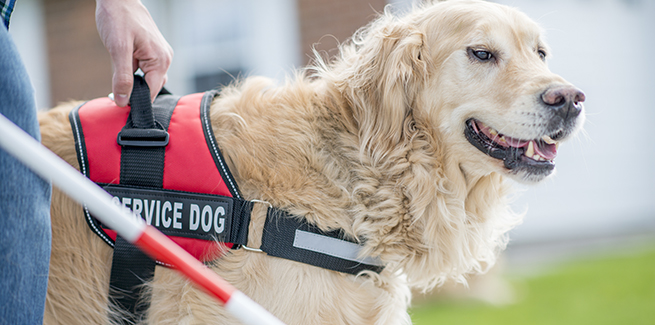Introducing the first AAHA guidelines for working, assistance, and therapy dogs

Would you know how to treat a highly trained bomb-sniffing dog who’s having a bout of explosive diarrhea? Here’s a tip—resist the impulse to reach for the metronidazole.
You can read more about that in the 2021 AAHA Working, Assistance, and Therapy Dog Guidelines (AAHA Working Dog Guidelines for short), the first ever comprehensive guidelines on caring for the dogs who care for us.
This category of canine patients includes a broad assortment of animals, some with well-defined functions and others that provide a more generalized support role. Many undergo extensive training and have rigorous physical demands placed upon them. These factors make working, assistance, and therapy dogs inherently valuable and in need of a high level of primary veterinary care.
The guidelines include recommendations for dogs trained for:
- Protection
- Odor/scent detection
- Service functions for people with diagnosed disabilities or physical limitations
- Emotional support
- Therapeutic intervention
Because working dogs have a particularly close relationship with their handlers, a trust relationship between the practice team and the working-dog client is imperative. The AAHA Working Dog Guidelines will help veterinary caregivers build that trust.
“These partners’ lives depend on each other,” guidelines task force chair Cynthia Otto, DVM, PhD, told NEWStat.
A professor of Working Dog Sciences and Sports Medicine at the University of Pennsylvania School of Veterinary Medicine and director of the Penn Vet Working Dog Center, Otto said the bond between a working dog and their handlers is extremely strong, and veterinary caregivers need to be attuned to that bond—and respect it: “The handlers may notice subtle changes that impact their work and reflect an underlying medical condition that might otherwise not be readily recognized.”
Otto said the critical nature of that bond “warrants involving the handler in the treatment to a greater extent than might be found with the owner of a companion dog.”
Task force member Debra Zoran, DVM, PhD, DACVIM-SAIM, a professor of small animal clinical sciences at Texas A&M and associate director of the school’s Veterinary Emergency Team, told NEWStat that treating working dogs is definitely different than treating companion animal dogs, and the guidelines address that.
“Many veterinarians don’t have the background or experience working with them to understand how different they are from typical pet dogs,” Zoran said. “[The Working Dog Guidelines] brought together professionals from all aspects of the working dog world to put together a manuscript that will help bridge this gap.”
“Working dogs are still dogs—medically and surgically,” Zoran stressed. “But, behaviorally, they’re uniquely suited to working in very high-stress, high-demand jobs.”
These aren’t couch-potato dogs, she added: “The jobs they do often require a high level of fitness, training time, and excellent nutrition.” Like Otto, Zoran stressed the importance of respecting the handler/canine bond: “It’s interwoven into the partnership,” she said. “All pet owners develop bonds with their companions—some that are exceptionally tight—but the hours of training, deployments, and daily connectedness [with their handlers] make this veterinarian/client/patient relationship completely different.”
And about that metronidazole . . .
Task force member Zenithson Ng, DVM, MS, DABVP, a clinical associate professor of small animal clinical sciences at the University of Tennessee College of Veterinary Medicine, told NEWStat that the guidelines will help veterinarians to think about things they may not have thought of before when treating working dogs with special skills.
Like bomb-sniffing dogs.
“The guidelines give insight into the day in the life of these dogs so that a veterinarian can make recommendations that decrease health risks and increase performance,” Ng said. “For example, how many people know that metronidazole (Flagyl) can decrease a dog’s accuracy in scent detection?”
It’s in the guidelines. And it’s something to think about the next time you treat a bomb-sniffing dog with bowel issues.
For a printable PDF of the 2021 AAHA Working, Assistance, and Therapy Dog Guidelines, click here.
Photo Credit: © FatCamera/iStock/Getty Images Plus via Getty Images Plus



